JEEP GRAND CHEROKEE 2011 Owner handbook (in English)
Manufacturer: JEEP, Model Year: 2011, Model line: GRAND CHEROKEE, Model: JEEP GRAND CHEROKEE 2011Pages: 350, PDF Size: 4.58 MB
Page 161 of 350
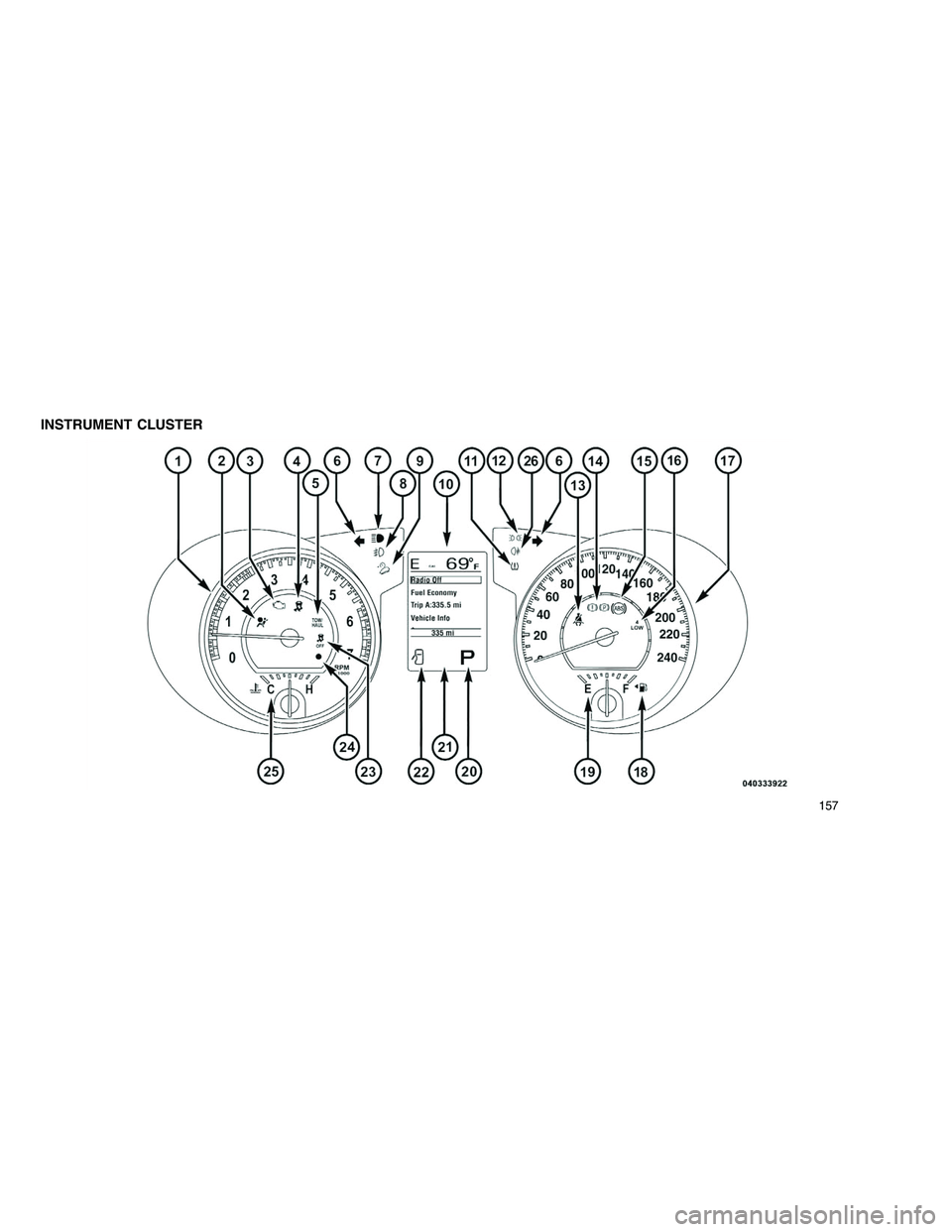
INSTRUMENT CLUSTER
157
Page 162 of 350
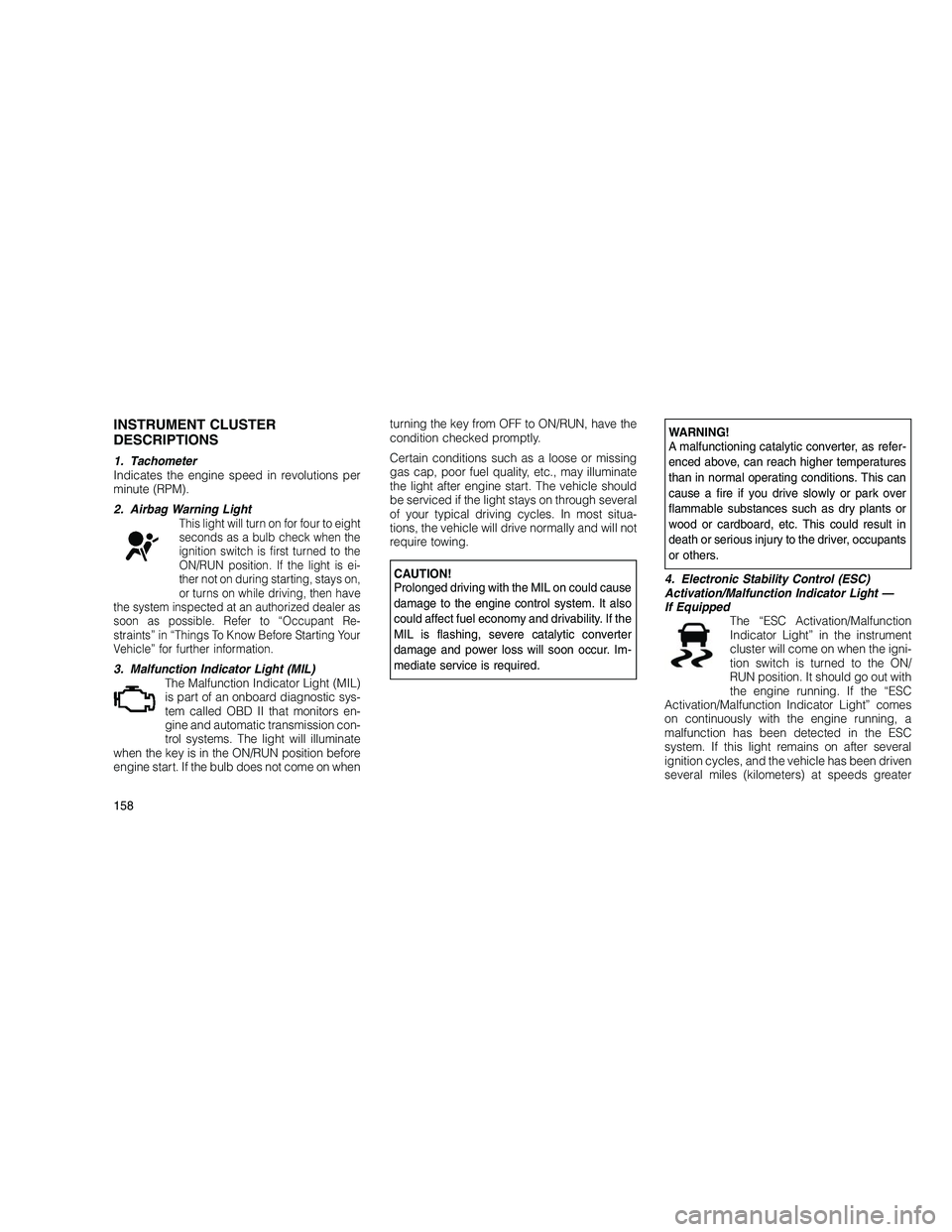
INSTRUMENT CLUSTER
DESCRIPTIONS
1. Tachometer
Indicates the engine speed in revolutions per
minute (RPM).
2. Airbag Warning Light
This light will turn on for four to eight
seconds as a bulb check when the
ignition switch is first turned to the
ON/RUN position. If the light is ei-
ther not on during starting, stays on,
or turns on while driving, then have
the system inspected at an authorized dealer as
soon as possible. Refer to “Occupant Re-
straints” in “Things To Know Before Starting Your
Vehicle” for further information.
3. Malfunction Indicator Light (MIL) The Malfunction Indicator Light (MIL)
is part of an onboard diagnostic sys-
tem called OBD II that monitors en-
gine and automatic transmission con-
trol systems. The light will illuminate
when the key is in the ON/RUN position before
engine start. If the bulb does not come on when turning the key from OFF to ON/RUN, have the
condition checked promptly.
Certain conditions such as a loose or missing
gas cap, poor fuel quality, etc., may illuminate
the light after engine start. The vehicle should
be serviced if the light stays on through several
of your typical driving cycles. In most situa-
tions, the vehicle will drive normally and will not
require towing.
CAUTION!
Prolonged driving with the MIL on could cause
damage to the engine control system. It also
could affect fuel economy and drivability. If the
MIL is flashing, severe catalytic converter
damage and power loss will soon occur. Im-
mediate service is required.
WARNING!
A malfunctioning catalytic converter, as refer-
enced above, can reach higher temperatures
than in normal operating conditions. This can
cause a fire if you drive slowly or park over
flammable substances such as dry plants or
wood or cardboard, etc. This could result in
death or serious injury to the driver, occupants
or others.
4. Electronic Stability Control (ESC)
Activation/Malfunction Indicator Light —
If Equipped The “ESC Activation/Malfunction
Indicator Light” in the instrument
cluster will come on when the igni-
tion switch is turned to the ON/
RUN position. It should go out with
the engine running. If the “ESC
Activation/Malfunction Indicator Light” comes
on continuously with the engine running, a
malfunction has been detected in the ESC
system. If this light remains on after several
ignition cycles, and the vehicle has been driven
several miles (kilometers) at speeds greater
158
Page 163 of 350
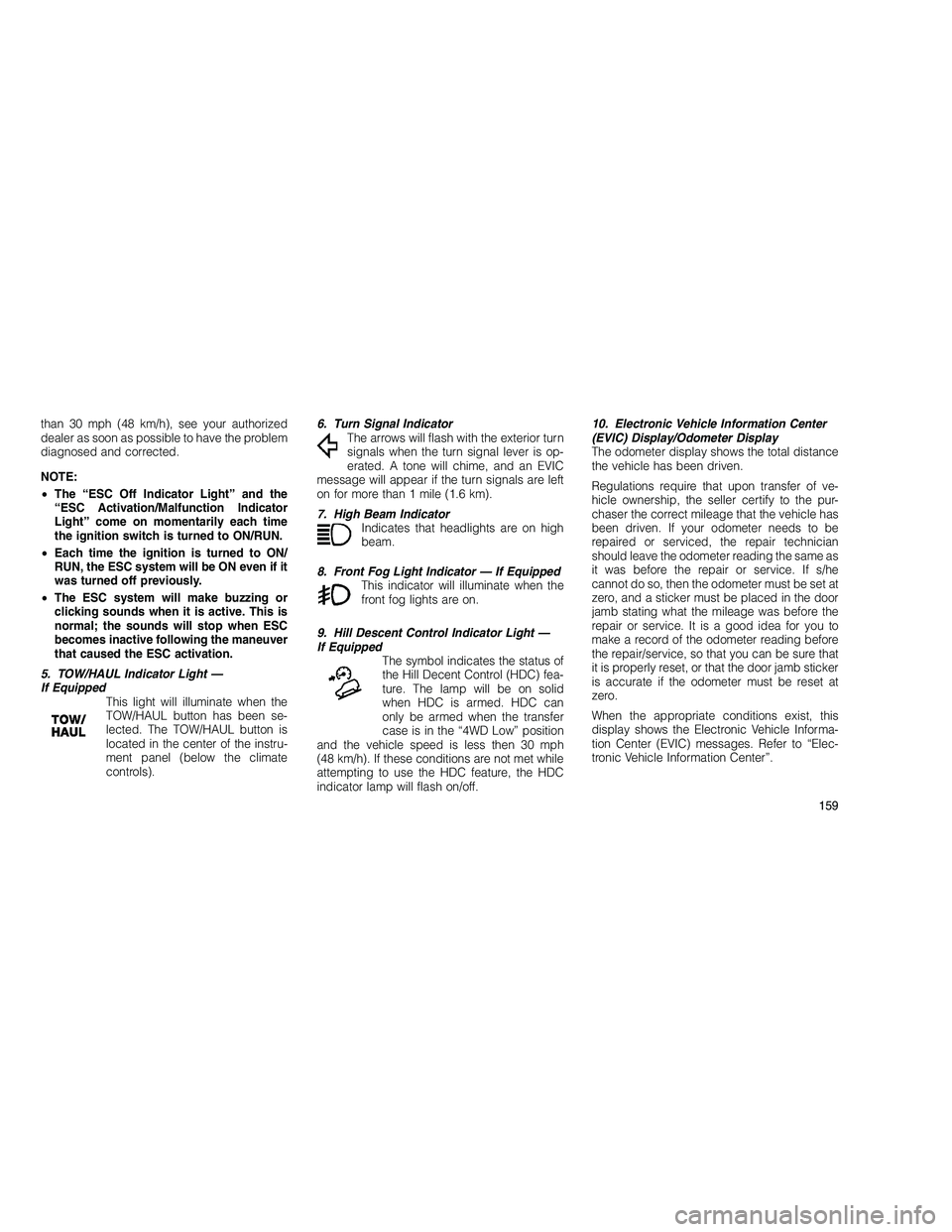
than 30 mph (48 km/h), see your authorized
dealer as soon as possible to have the problem
diagnosed and corrected.
NOTE:
•The “ESC Off Indicator Light” and the
“ESC Activation/Malfunction Indicator
Light” come on momentarily each time
the ignition switch is turned to ON/RUN.
• Each time the ignition is turned to ON/
RUN, the ESC system will be ON even if it
was turned off previously.
• The ESC system will make buzzing or
clicking sounds when it is active. This is
normal; the sounds will stop when ESC
becomes inactive following the maneuver
that caused the ESC activation.
5. TOW/HAUL Indicator Light —
If Equipped This light will illuminate when the
TOW/HAUL button has been se-
lected. The TOW/HAUL button is
located in the center of the instru-
ment panel (below the climate
controls). 6. Turn Signal Indicator
The arrows will flash with the exterior turn
signals when the turn signal lever is op-
erated. A tone will chime, and an EVIC
message will appear if the turn signals are left
on for more than 1 mile (1.6 km).
7. High Beam Indicator Indicates that headlights are on high
beam.
8. Front Fog Light Indicator — If Equipped This indicator will illuminate when the
front fog lights are on.
9. Hill Descent Control Indicator Light —
If Equipped The symbol indicates the status of
the Hill Decent Control (HDC) fea-
ture. The lamp will be on solid
when HDC is armed. HDC can
only be armed when the transfer
case is in the “4WD Low” position
and the vehicle speed is less then 30 mph
(48 km/h). If these conditions are not met while
attempting to use the HDC feature, the HDC
indicator lamp will flash on/off. 10. Electronic Vehicle Information Center
(EVIC) Display/Odometer Display
The odometer display shows the total distance
the vehicle has been driven.
Regulations require that upon transfer of ve-
hicle ownership, the seller certify to the pur-
chaser the correct mileage that the vehicle has
been driven. If your odometer needs to be
repaired or serviced, the repair technician
should leave the odometer reading the same as
it was before the repair or service. If s/he
cannot do so, then the odometer must be set at
zero, and a sticker must be placed in the door
jamb stating what the mileage was before the
repair or service. It is a good idea for you to
make a record of the odometer reading before
the repair/service, so that you can be sure that
it is properly reset, or that the door jamb sticker
is accurate if the odometer must be reset at
zero.
When the appropriate conditions exist, this
display shows the Electronic Vehicle Informa-
tion Center (EVIC) messages. Refer to “Elec-
tronic Vehicle Information Center”.
159
Page 164 of 350
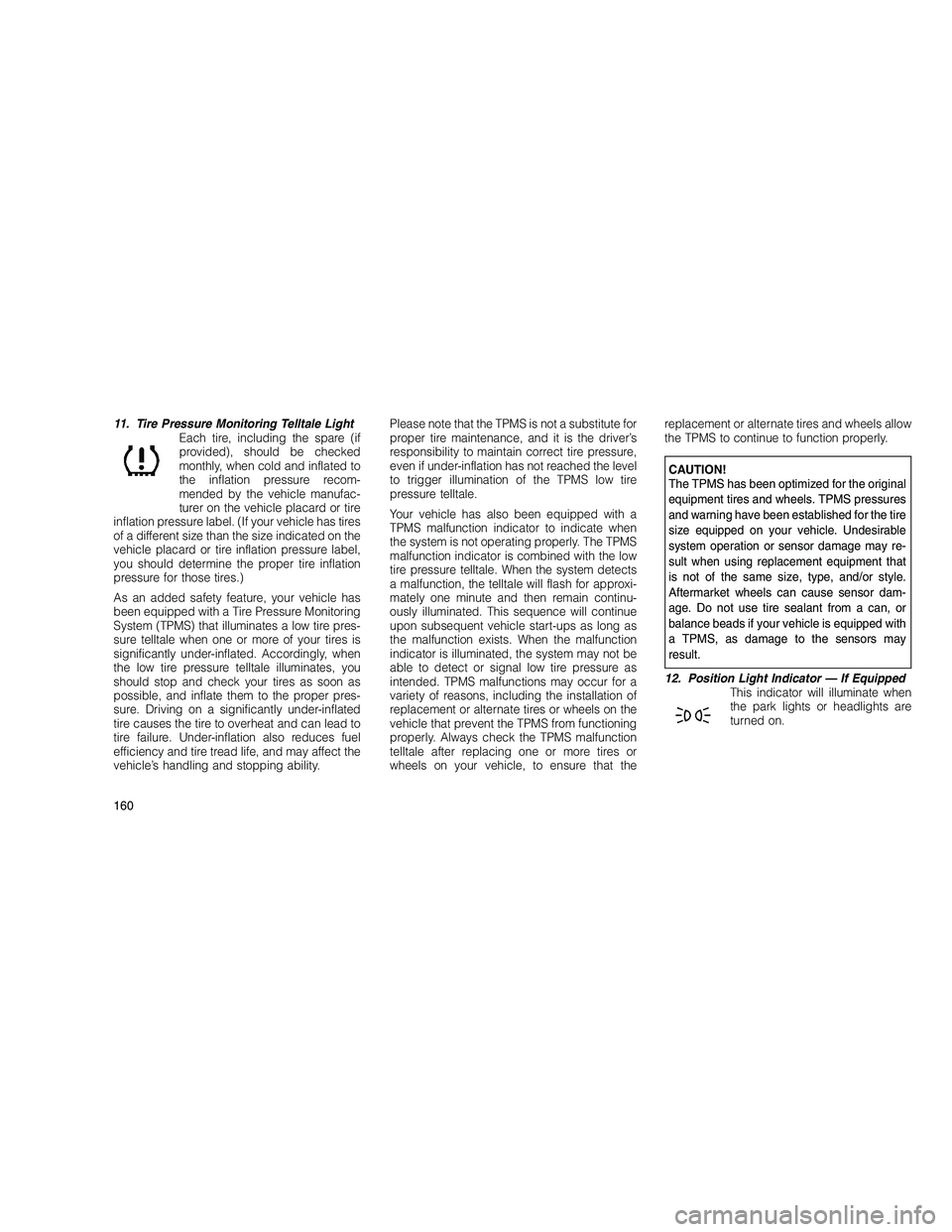
11. Tire Pressure Monitoring Telltale LightEach tire, including the spare (if
provided), should be checked
monthly, when cold and inflated to
the inflation pressure recom-
mended by the vehicle manufac-
turer on the vehicle placard or tire
inflation pressure label. (If your vehicle has tires
of a different size than the size indicated on the
vehicle placard or tire inflation pressure label,
you should determine the proper tire inflation
pressure for those tires.)
As an added safety feature, your vehicle has
been equipped with a Tire Pressure Monitoring
System (TPMS) that illuminates a low tire pres-
sure telltale when one or more of your tires is
significantly under-inflated. Accordingly, when
the low tire pressure telltale illuminates, you
should stop and check your tires as soon as
possible, and inflate them to the proper pres-
sure. Driving on a significantly under-inflated
tire causes the tire to overheat and can lead to
tire failure. Under-inflation also reduces fuel
efficiency and tire tread life, and may affect the
vehicle’s handling and stopping ability. Please note that the TPMS is not a substitute for
proper tire maintenance, and it is the driver’s
responsibility to maintain correct tire pressure,
even if under-inflation has not reached the level
to trigger illumination of the TPMS low tire
pressure telltale.
Your vehicle has also been equipped with a
TPMS malfunction indicator to indicate when
the system is not operating properly. The TPMS
malfunction indicator is combined with the low
tire pressure telltale. When the system detects
a malfunction, the telltale will flash for approxi-
mately one minute and then remain continu-
ously illuminated. This sequence will continue
upon subsequent vehicle start-ups as long as
the malfunction exists. When the malfunction
indicator is illuminated, the system may not be
able to detect or signal low tire pressure as
intended. TPMS malfunctions may occur for a
variety of reasons, including the installation of
replacement or alternate tires or wheels on the
vehicle that prevent the TPMS from functioning
properly. Always check the TPMS malfunction
telltale after replacing one or more tires or
wheels on your vehicle, to ensure that thereplacement or alternate tires and wheels allow
the TPMS to continue to function properly.
CAUTION!
The TPMS has been optimized for the original
equipment tires and wheels. TPMS pressures
and warning have been established for the tire
size equipped on your vehicle. Undesirable
system operation or sensor damage may re-
sult when using replacement equipment that
is not of the same size, type, and/or style.
Aftermarket wheels can cause sensor dam-
age. Do not use tire sealant from a can, or
balance beads if your vehicle is equipped with
a TPMS, as damage to the sensors may
result.
12. Position Light Indicator — If Equipped This indicator will illuminate when
the park lights or headlights are
turned on.
160
Page 165 of 350
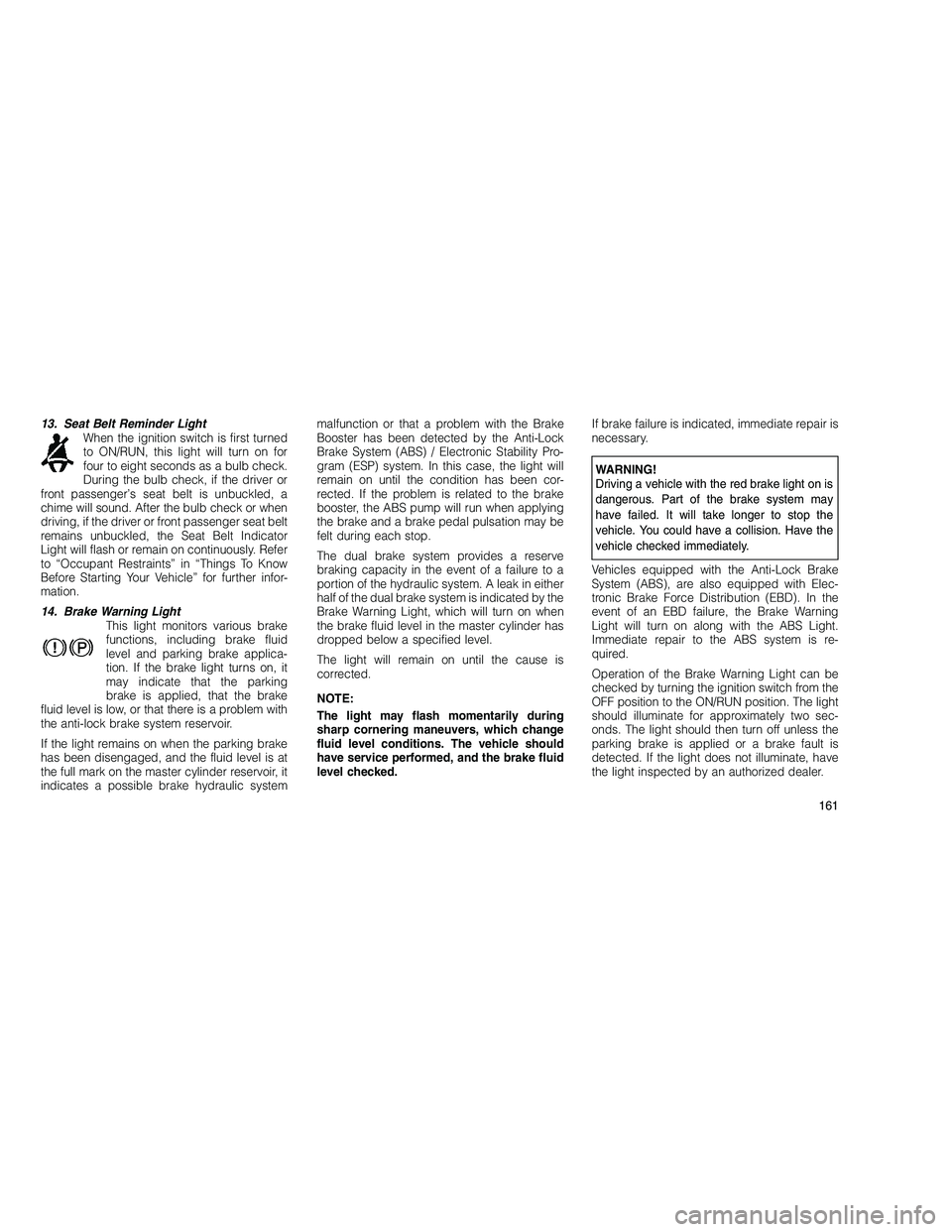
13. Seat Belt Reminder LightWhen the ignition switch is first turned
to ON/RUN, this light will turn on for
four to eight seconds as a bulb check.
During the bulb check, if the driver or
front passenger’s seat belt is unbuckled, a
chime will sound. After the bulb check or when
driving, if the driver or front passenger seat belt
remains unbuckled, the Seat Belt Indicator
Light will flash or remain on continuously. Refer
to “Occupant Restraints” in “Things To Know
Before Starting Your Vehicle” for further infor-
mation.
14. Brake Warning Light This light monitors various brake
functions, including brake fluid
level and parking brake applica-
tion. If the brake light turns on, it
may indicate that the parking
brake is applied, that the brake
fluid level is low, or that there is a problem with
the anti-lock brake system reservoir.
If the light remains on when the parking brake
has been disengaged, and the fluid level is at
the full mark on the master cylinder reservoir, it
indicates a possible brake hydraulic system malfunction or that a problem with the Brake
Booster has been detected by the Anti-Lock
Brake System (ABS) / Electronic Stability Pro-
gram (ESP) system. In this case, the light will
remain on until the condition has been cor-
rected. If the problem is related to the brake
booster, the ABS pump will run when applying
the brake and a brake pedal pulsation may be
felt during each stop.
The dual brake system provides a reserve
braking capacity in the event of a failure to a
portion of the hydraulic system. A leak in either
half of the dual brake system is indicated by the
Brake Warning Light, which will turn on when
the brake fluid level in the master cylinder has
dropped below a specified level.
The light will remain on until the cause is
corrected.
NOTE:
The light may flash momentarily during
sharp cornering maneuvers, which change
fluid level conditions. The vehicle should
have service performed, and the brake fluid
level checked.
If brake failure is indicated, immediate repair is
necessary.
WARNING!
Driving a vehicle with the red brake light on is
dangerous. Part of the brake system may
have failed. It will take longer to stop the
vehicle. You could have a collision. Have the
vehicle checked immediately.
Vehicles equipped with the Anti-Lock Brake
System (ABS), are also equipped with Elec-
tronic Brake Force Distribution (EBD). In the
event of an EBD failure, the Brake Warning
Light will turn on along with the ABS Light.
Immediate repair to the ABS system is re-
quired.
Operation of the Brake Warning Light can be
checked by turning the ignition switch from the
OFF position to the ON/RUN position. The light
should illuminate for approximately two sec-
onds. The light should then turn off unless the
parking brake is applied or a brake fault is
detected. If the light does not illuminate, have
the light inspected by an authorized dealer.
161
Page 166 of 350
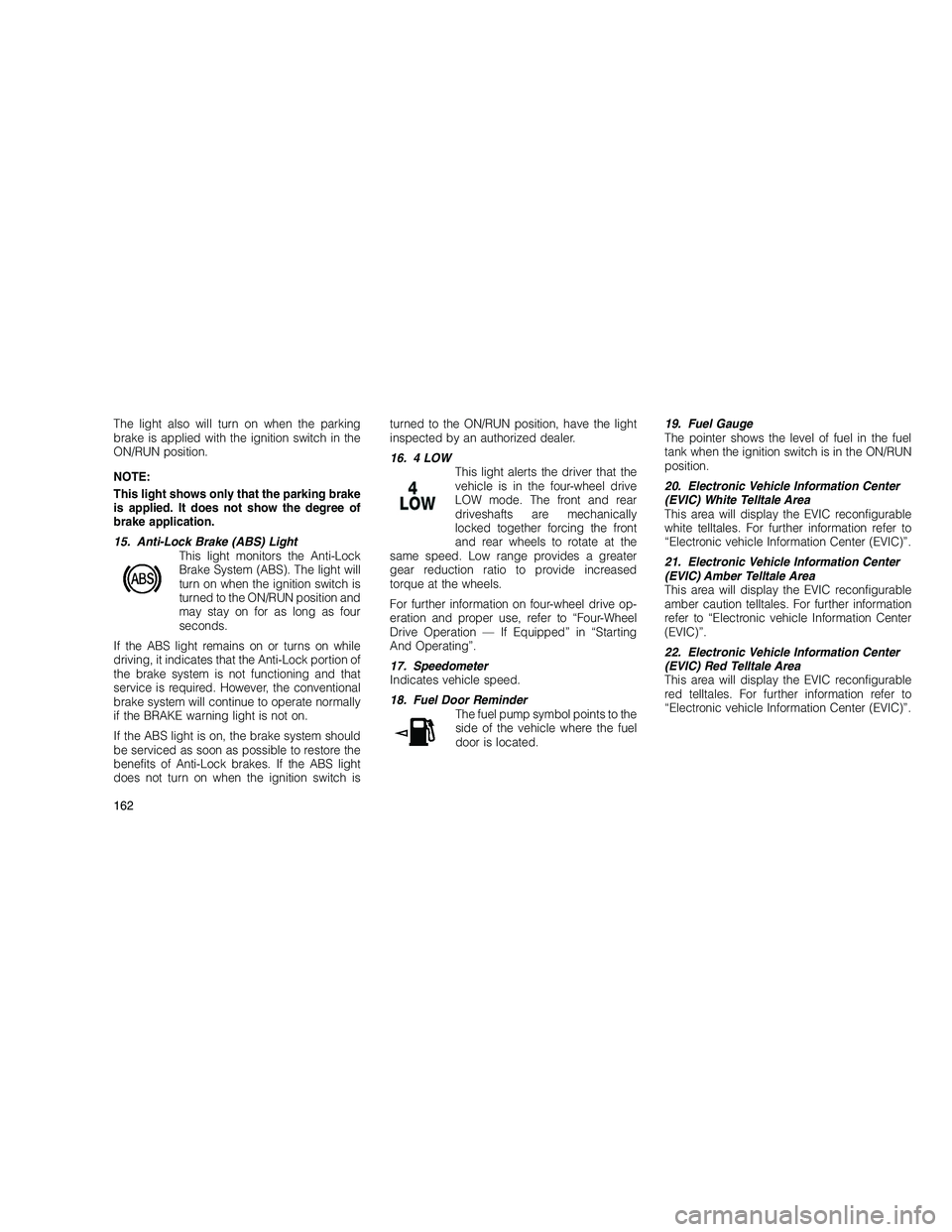
The light also will turn on when the parking
brake is applied with the ignition switch in the
ON/RUN position.
NOTE:
This light shows only that the parking brake
is applied. It does not show the degree of
brake application.
15. Anti-Lock Brake (ABS) LightThis light monitors the Anti-Lock
Brake System (ABS). The light will
turn on when the ignition switch is
turned to the ON/RUN position and
may stay on for as long as four
seconds.
If the ABS light remains on or turns on while
driving, it indicates that the Anti-Lock portion of
the brake system is not functioning and that
service is required. However, the conventional
brake system will continue to operate normally
if the BRAKE warning light is not on.
If the ABS light is on, the brake system should
be serviced as soon as possible to restore the
benefits of Anti-Lock brakes. If the ABS light
does not turn on when the ignition switch is turned to the ON/RUN position, have the light
inspected by an authorized dealer.
16. 4 LOW
This light alerts the driver that the
vehicle is in the four-wheel drive
LOW mode. The front and rear
driveshafts are mechanically
locked together forcing the front
and rear wheels to rotate at the
same speed. Low range provides a greater
gear reduction ratio to provide increased
torque at the wheels.
For further information on four-wheel drive op-
eration and proper use, refer to “Four-Wheel
Drive Operation — If Equipped” in “Starting
And Operating”.
17. Speedometer
Indicates vehicle speed.
18. Fuel Door Reminder The fuel pump symbol points to the
side of the vehicle where the fuel
door is located. 19. Fuel Gauge
The pointer shows the level of fuel in the fuel
tank when the ignition switch is in the ON/RUN
position.
20. Electronic Vehicle Information Center
(EVIC) White Telltale Area
This area will display the EVIC reconfigurable
white telltales. For further information refer to
“Electronic vehicle Information Center (EVIC)”.
21. Electronic Vehicle Information Center
(EVIC) Amber Telltale Area
This area will display the EVIC reconfigurable
amber caution telltales. For further information
refer to “Electronic vehicle Information Center
(EVIC)”.
22. Electronic Vehicle Information Center
(EVIC) Red Telltale Area
This area will display the EVIC reconfigurable
red telltales. For further information refer to
“Electronic vehicle Information Center (EVIC)”.
162
Page 167 of 350
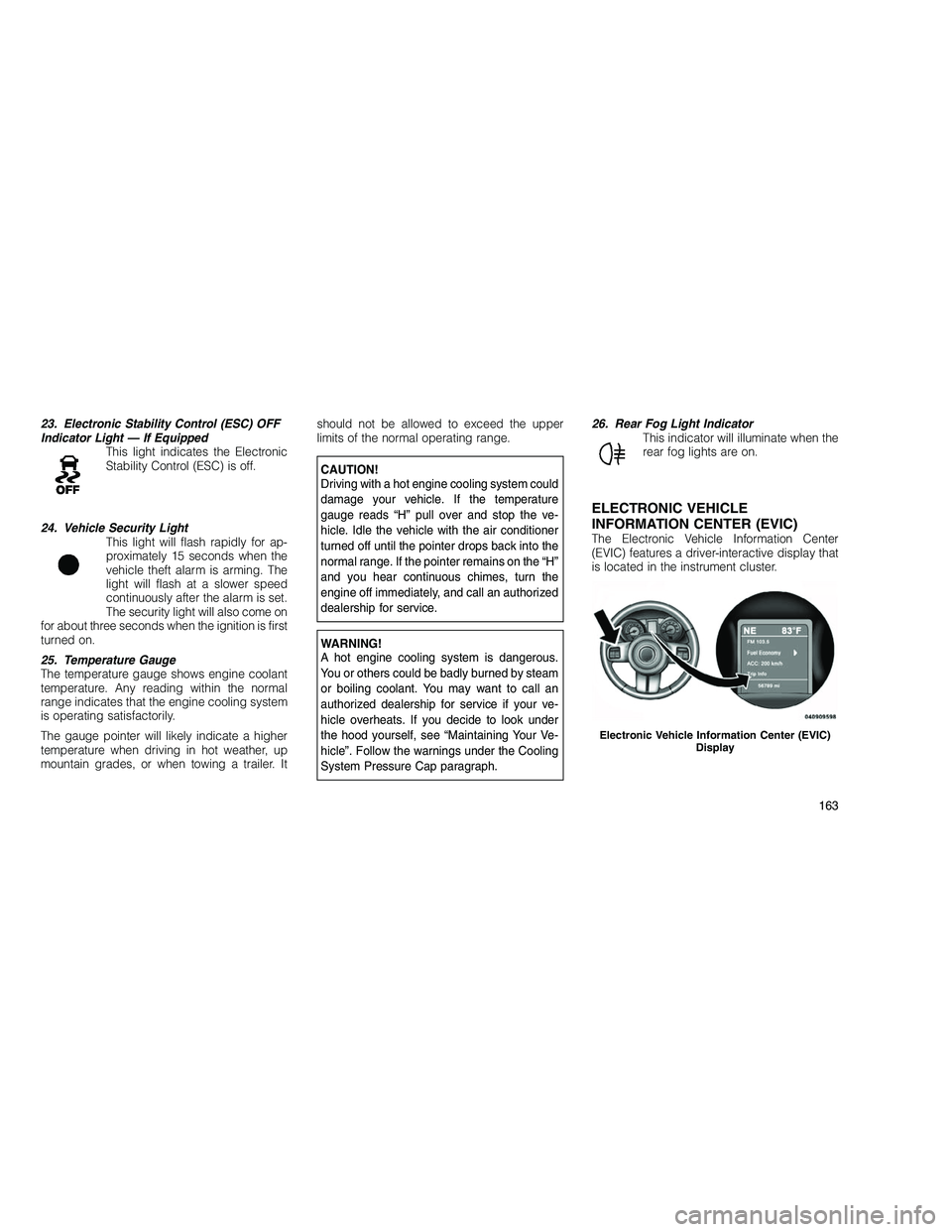
23. Electronic Stability Control (ESC) OFF
Indicator Light — If EquippedThis light indicates the Electronic
Stability Control (ESC) is off.
24. Vehicle Security Light This light will flash rapidly for ap-
proximately 15 seconds when the
vehicle theft alarm is arming. The
light will flash at a slower speed
continuously after the alarm is set.
The security light will also come on
for about three seconds when the ignition is first
turned on.
25. Temperature Gauge
The temperature gauge shows engine coolant
temperature. Any reading within the normal
range indicates that the engine cooling system
is operating satisfactorily.
The gauge pointer will likely indicate a higher
temperature when driving in hot weather, up
mountain grades, or when towing a trailer. It should not be allowed to exceed the upper
limits of the normal operating range.
CAUTION!
Driving with a hot engine cooling system could
damage your vehicle. If the temperature
gauge reads “H” pull over and stop the ve-
hicle. Idle the vehicle with the air conditioner
turned off until the pointer drops back into the
normal range. If the pointer remains on the “H”
and you hear continuous chimes, turn the
engine off immediately, and call an authorized
dealership for service.
WARNING!
A hot engine cooling system is dangerous.
You or others could be badly burned by steam
or boiling coolant. You may want to call an
authorized dealership for service if your ve-
hicle overheats. If you decide to look under
the hood yourself, see “Maintaining Your Ve-
hicle”. Follow the warnings under the Cooling
System Pressure Cap paragraph.26. Rear Fog Light Indicator
This indicator will illuminate when the
rear fog lights are on.
ELECTRONIC VEHICLE
INFORMATION CENTER (EVIC)
The Electronic Vehicle Information Center
(EVIC) features a driver-interactive display that
is located in the instrument cluster.
Electronic Vehicle Information Center (EVIC)
Display
163
Page 168 of 350
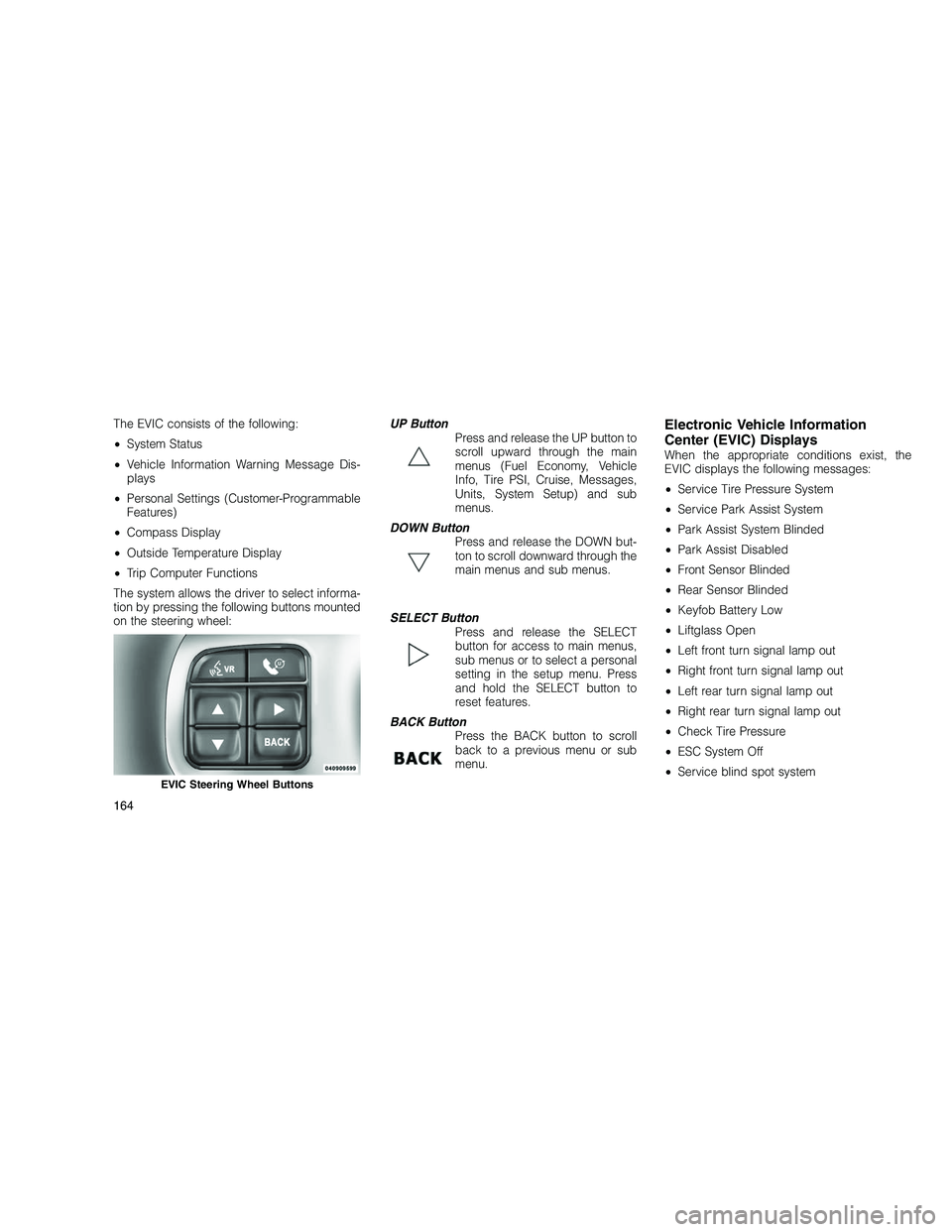
The EVIC consists of the following:
•System Status
• Vehicle Information Warning Message Dis-
plays
• Personal Settings (Customer-Programmable
Features)
• Compass Display
• Outside Temperature Display
• Trip Computer Functions
The system allows the driver to select informa-
tion by pressing the following buttons mounted
on the steering wheel: UP Button
Press and release the UP button to
scroll upward through the main
menus (Fuel Economy, Vehicle
Info, Tire PSI, Cruise, Messages,
Units, System Setup) and sub
menus.
DOWN Button Press and release the DOWN but-
ton to scroll downward through the
main menus and sub menus.
SELECT Button Press and release the SELECT
button for access to main menus,
sub menus or to select a personal
setting in the setup menu. Press
and hold the SELECT button to
reset features.
BACK Button Press the BACK button to scroll
back to a previous menu or sub
menu.Electronic Vehicle Information
Center (EVIC) Displays
When the appropriate conditions exist, the
EVIC displays the following messages:
•Service Tire Pressure System
• Service Park Assist System
• Park Assist System Blinded
• Park Assist Disabled
• Front Sensor Blinded
• Rear Sensor Blinded
• Keyfob Battery Low
• Liftglass Open
• Left front turn signal lamp out
• Right front turn signal lamp out
• Left rear turn signal lamp out
• Right rear turn signal lamp out
• Check Tire Pressure
• ESC System Off
• Service blind spot system
EVIC Steering Wheel Buttons
164
Page 169 of 350
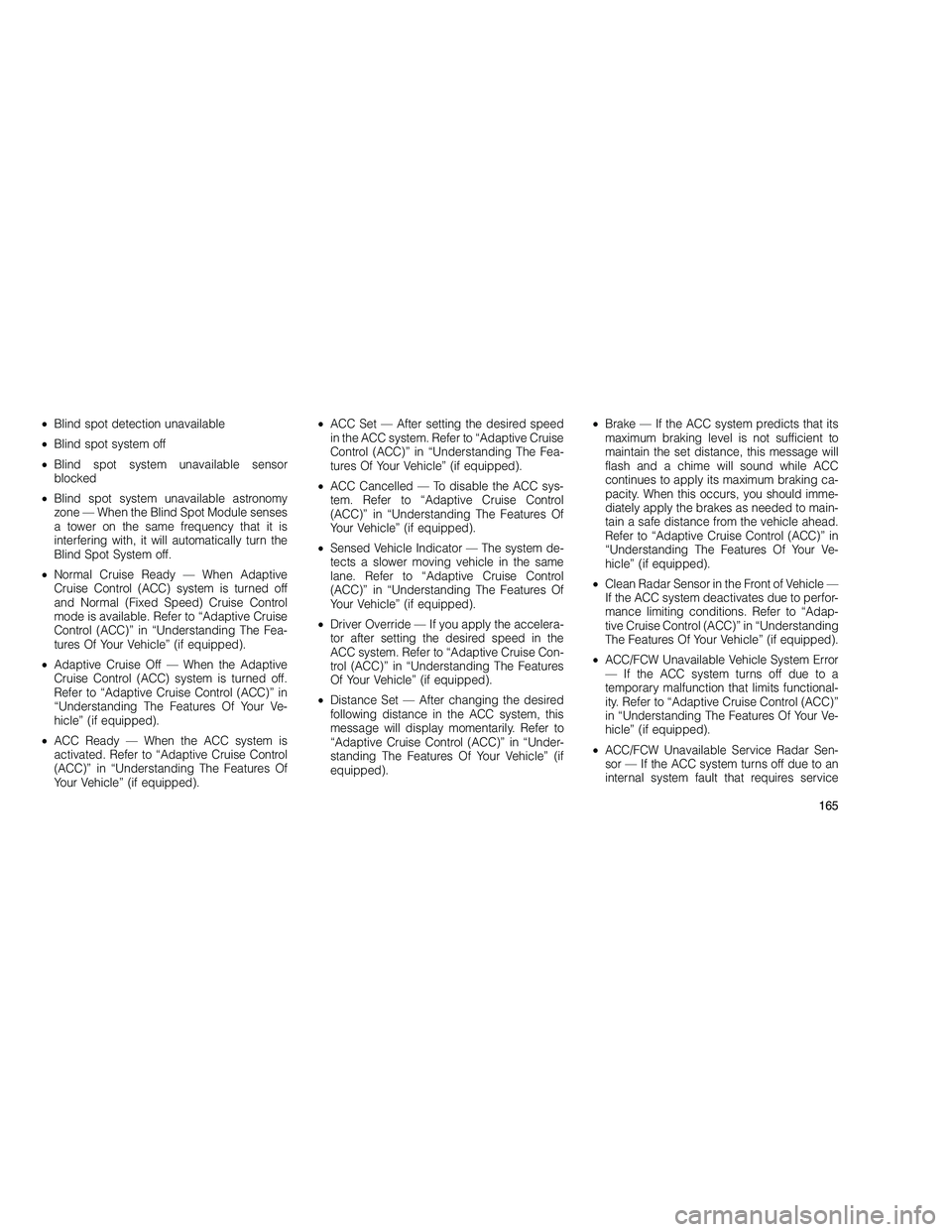
•Blind spot detection unavailable
• Blind spot system off
• Blind spot system unavailable sensor
blocked
• Blind spot system unavailable astronomy
zone — When the Blind Spot Module senses
a tower on the same frequency that it is
interfering with, it will automatically turn the
Blind Spot System off.
• Normal Cruise Ready — When Adaptive
Cruise Control (ACC) system is turned off
and Normal (Fixed Speed) Cruise Control
mode is available. Refer to “Adaptive Cruise
Control (ACC)” in “Understanding The Fea-
tures Of Your Vehicle” (if equipped).
• Adaptive Cruise Off — When the Adaptive
Cruise Control (ACC) system is turned off.
Refer to “Adaptive Cruise Control (ACC)” in
“Understanding The Features Of Your Ve-
hicle” (if equipped).
• ACC Ready — When the ACC system is
activated. Refer to “Adaptive Cruise Control
(ACC)” in “Understanding The Features Of
Your Vehicle” (if equipped). •
ACC Set — After setting the desired speed
in the ACC system. Refer to “Adaptive Cruise
Control (ACC)” in “Understanding The Fea-
tures Of Your Vehicle” (if equipped).
• ACC Cancelled — To disable the ACC sys-
tem. Refer to “Adaptive Cruise Control
(ACC)” in “Understanding The Features Of
Your Vehicle” (if equipped).
• Sensed Vehicle Indicator — The system de-
tects a slower moving vehicle in the same
lane. Refer to “Adaptive Cruise Control
(ACC)” in “Understanding The Features Of
Your Vehicle” (if equipped).
• Driver Override — If you apply the accelera-
tor after setting the desired speed in the
ACC system. Refer to “Adaptive Cruise Con-
trol (ACC)” in “Understanding The Features
Of Your Vehicle” (if equipped).
• Distance Set — After changing the desired
following distance in the ACC system, this
message will display momentarily. Refer to
“Adaptive Cruise Control (ACC)” in “Under-
standing The Features Of Your Vehicle” (if
equipped). •
Brake — If the ACC system predicts that its
maximum braking level is not sufficient to
maintain the set distance, this message will
flash and a chime will sound while ACC
continues to apply its maximum braking ca-
pacity. When this occurs, you should imme-
diately apply the brakes as needed to main-
tain a safe distance from the vehicle ahead.
Refer to “Adaptive Cruise Control (ACC)” in
“Understanding The Features Of Your Ve-
hicle” (if equipped).
• Clean Radar Sensor in the Front of Vehicle —
If the ACC system deactivates due to perfor-
mance limiting conditions. Refer to “Adap-
tive Cruise Control (ACC)” in “Understanding
The Features Of Your Vehicle” (if equipped).
• ACC/FCW Unavailable Vehicle System Error
— If the ACC system turns off due to a
temporary malfunction that limits functional-
ity. Refer to “Adaptive Cruise Control (ACC)”
in “Understanding The Features Of Your Ve-
hicle” (if equipped).
• ACC/FCW Unavailable Service Radar Sen-
sor — If the ACC system turns off due to an
internal system fault that requires service
165
Page 170 of 350
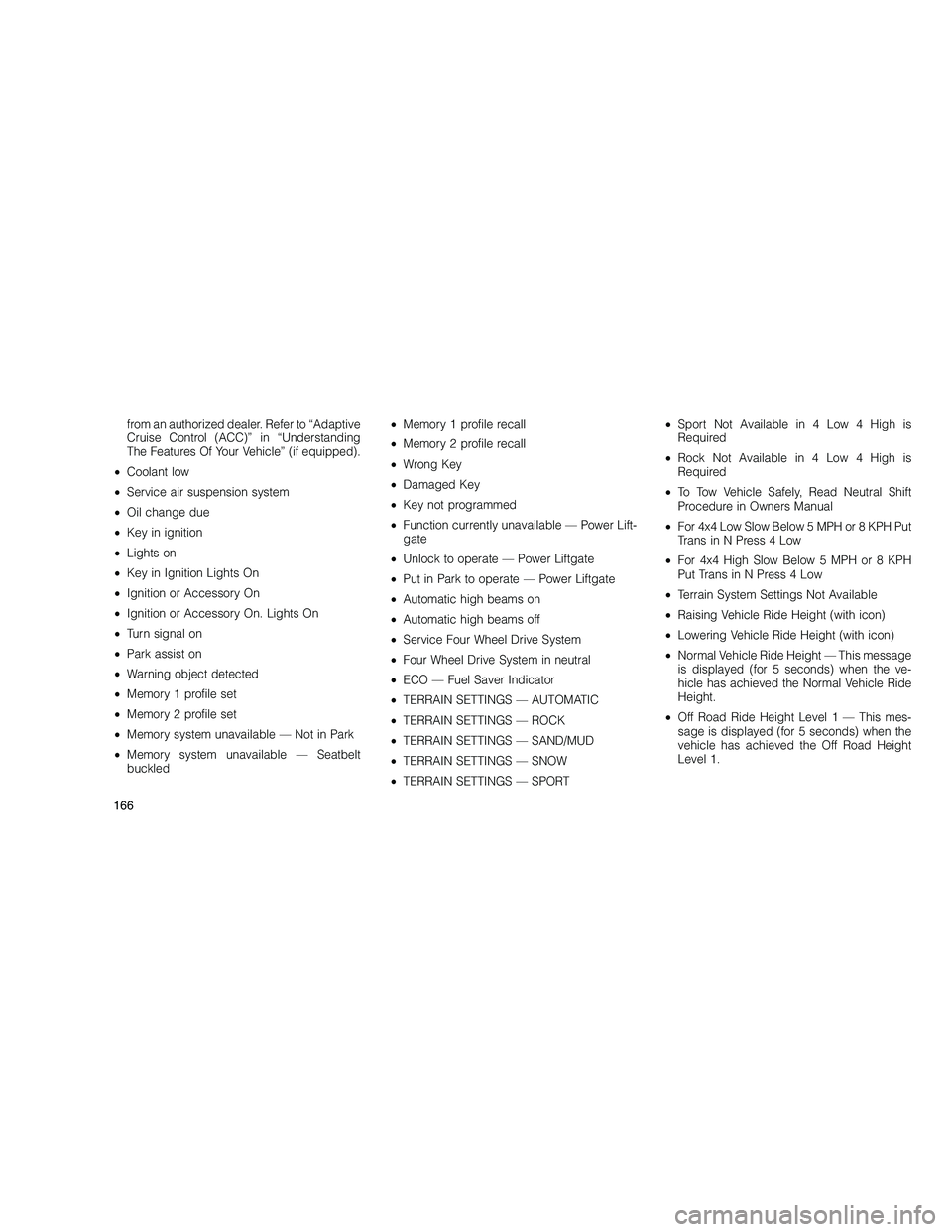
from an authorized dealer. Refer to “Adaptive
Cruise Control (ACC)” in “Understanding
The Features Of Your Vehicle” (if equipped).
• Coolant low
• Service air suspension system
• Oil change due
• Key in ignition
• Lights on
• Key in Ignition Lights On
• Ignition or Accessory On
• Ignition or Accessory On. Lights On
• Turn signal on
• Park assist on
• Warning object detected
• Memory 1 profile set
• Memory 2 profile set
• Memory system unavailable — Not in Park
• Memory system unavailable — Seatbelt
buckled •
Memory 1 profile recall
• Memory 2 profile recall
• Wrong Key
• Damaged Key
• Key not programmed
• Function currently unavailable — Power Lift-
gate
• Unlock to operate — Power Liftgate
• Put in Park to operate — Power Liftgate
• Automatic high beams on
• Automatic high beams off
• Service Four Wheel Drive System
• Four Wheel Drive System in neutral
• ECO — Fuel Saver Indicator
• TERRAIN SETTINGS — AUTOMATIC
• TERRAIN SETTINGS — ROCK
• TERRAIN SETTINGS — SAND/MUD
• TERRAIN SETTINGS — SNOW
• TERRAIN SETTINGS — SPORT •
Sport Not Available in 4 Low 4 High is
Required
• Rock Not Available in 4 Low 4 High is
Required
• To Tow Vehicle Safely, Read Neutral Shift
Procedure in Owners Manual
• For 4x4 Low Slow Below 5 MPH or 8 KPH Put
Trans in N Press 4 Low
• For 4x4 High Slow Below 5 MPH or 8 KPH
Put Trans in N Press 4 Low
• Terrain System Settings Not Available
• Raising Vehicle Ride Height (with icon)
• Lowering Vehicle Ride Height (with icon)
• Normal Vehicle Ride Height — This message
is displayed (for 5 seconds) when the ve-
hicle has achieved the Normal Vehicle Ride
Height.
• Off Road Ride Height Leve l 1 — This mes-
sage is displayed (for 5 seconds) when the
vehicle has achieved the Off Road Height
Level 1.
166